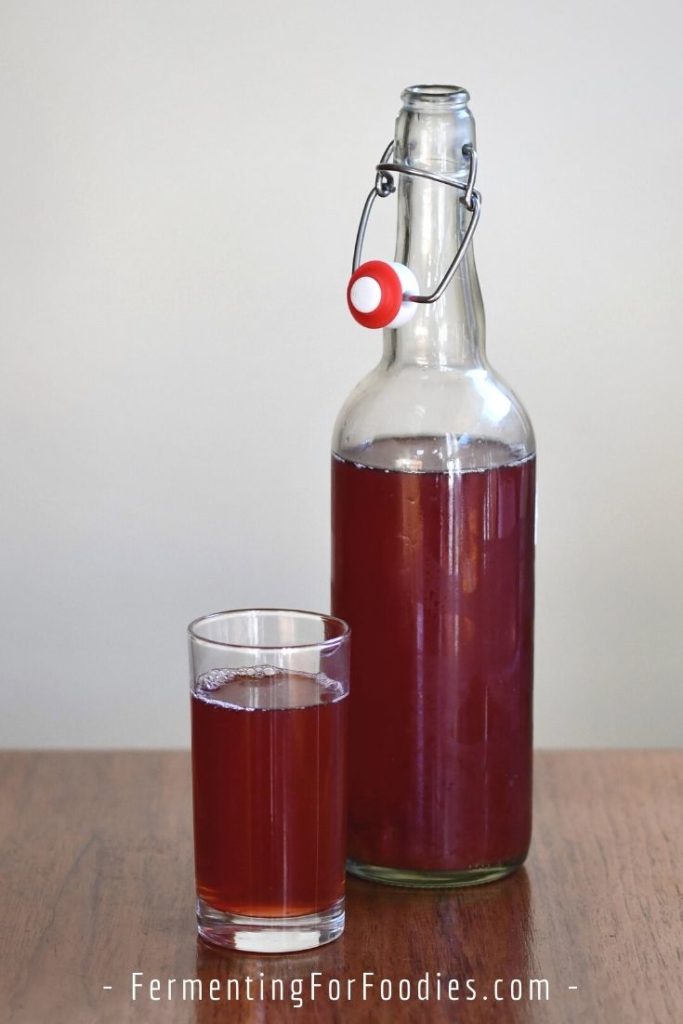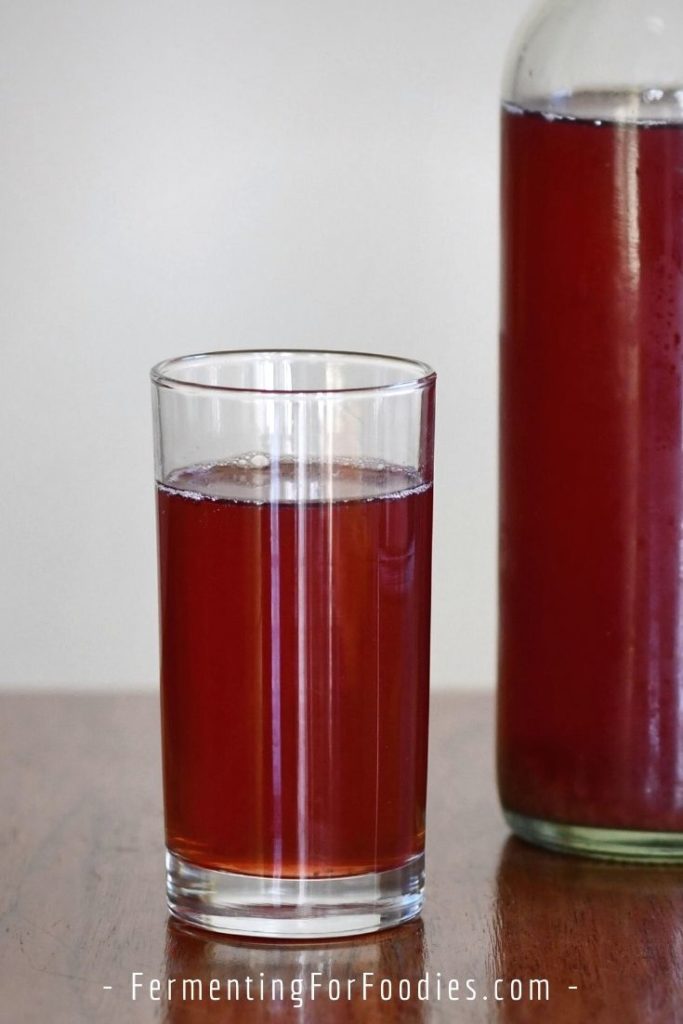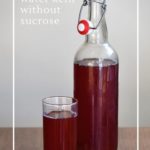Water kefir is a sweet fermented pop that lives on sugar and molasses. However, water kefir grains can be used to ferment other sweet liquids, like honey, juice, or coconut water. Here is everything you need to know to make water kefir without sugar.

How to culture water kefir without sugar
To be clear, water kefir grains really do need sugar and molasses (or dried fruit) to thrive.
It is not the most robust culture and really isn’t great at being pushed outside of its usual diet. Water kefir made without sucrose (sugar) won’t be as fizzy.
Here are three different ways of making water kefir without sugar:
- Use excess grains to make sugarless water kefir. Then it doesn’t matter if they aren’t healthy and happy.
- Refresh the grains in a sugar, molasses, and water mixture after every non-sugar ferment to keep the grains healthy.
- Make a sugar-free second ferment. There are lots of ways to flavor water kefir without sugar when bottling.
Alternatives to Sugar
It is happiest being fed sucrose. It doesn’t matter whether it’s raw sugar, brown sugar, or coconut palm sugar.
However, here are 3 sucrose-free alternatives to try.
Honey water kefir
- Heat 1/4 cup of filtered water and 1/4 cup of honey on the stove.
- Bring to a boil to pasteurize the honey. This will prevent any potential contamination from the natural yeasts and bacterial cultures in the honey.
- Mix the honey water with an additional 3 3/4 cups of filtered water and cool to room temperature.
- Culture with 3 Tbsp of water kefir grains.
- Ferment for 2 to 3 days, then flavor and bottle for a second ferment.
Coconut Water
- Mix 3 Tbsp of water kefir grains with 4 cups of coconut water.
- Ferment on the counter for 24-48 hours, then strain and bottle.
Juice Sweetened Water Kefir
- Mix 3 Tbsp of grains with 4 cups of clear juice (grape, apple, blueberry).
- Ferment for 24-48 hours then strain and bottle.
- Avoid acidic juices like orange or pineapple which will result in unpleasant yeasty strings.
- The fructose in the juice will result in a slightly alcoholic beverage, so it’s not recommended for children.



Why does the honey need to be pasteurised?
Raw honey contains its own bacterial culture, which ferments into mead, but is not the best for water kefir. If you only have raw honey, just mix it into boiling water to kill the culture first.
Hi Emillie!
Great and thoroughtful post with not that easy to find info. I’ve a simple question; is there a visual cue to tell if the grains are healthy or not? (color, flotability, texture, brightness, etc) ?
Thanks!!
Healthy grains will start to reproduce in sugar water. The colour will depend on your sugar (white or brown). Perhaps avoid experimenting with your water kefir grains until you have enough to make two different batches. I personally haven’t managed kill my grains, so I don’t know what that would look like!
Can I use xylitol as sweetener instead of sugar or honey?
Yes, but just like honey and other alternative sweeteners, it won’t be as sparkly. Water kefir really only eats sucrose (sugar). However, fine to use an alternative sweetener for a second ferment! 🙂 Enjoy!
How can I make water kefir without sugar or no sweets?
There must be a way to Ferment it?
I want to make hydrogen water Kefir.
Once Ferment it, I put-it in the refrigerator so the bacteria go to sleep.
Then when I drink it they wake-up and go all over my body and eat the sugar keeping me in ketosis.
Water kefir needs sugar to ferment. Otherwise the grains will starve. However, you don’t have to use any sugar for the second ferment. It won’t carbonate without sugar, as that’s a byproduct of the fermentation. If you are looking for a sugar-free and probiotic beverage, either try a salty vegetable kvass or a dairy-based ferment. https://www.fermentingforfoodies.com/salty-beet-kvass/
Cheers, Emillie
Is it possible to use kombucha Scoby instead of water kefir grains (can’t find them here in Australia)?
Thank you
Yes! I have a different post about making a less than happy kombucha (no tea and sugar-free). You can find it here: https://www.fermentingforfoodies.com/caffeine-free-sugar-free-kombucha/
Hi Norm, I found water kefir grains easily online in Australia. I ordered 2 tablespoons, and they have now multiplied to probably 2 cups worth in a few months. The grains were dehydrated slightly to be posted, but it was very easy to reconstitute before use. Gina
Thanks for sharing!
Is it good to rinse the grains in filtered water sometimes
If you’re brewing regularly, and everything is happy and healthy, then you don’t need to rinse your grains. However, if you are worried about contamination (like you dropped them on the floor or there was kahm yeast in your ferment) then you should definitely rinse them. Cheers!
Hello, how long do you ferment the honey kefir?
About 24-36 hours, just like typical water kefir. Enjoy!
How do you do a second ferment with these methods?
Brewing with an alternative sweetener is probably more similar to making a second ferment, as the yeast won’t be well fed by those sweeteners. However, feel free to flavour your water kefir as you would usually do after fermenting. You may not need to add more sweetener, because the kefir won’t have consumed it as it does with sugar. So taste before adding more honey/maple syrup, etc. Cheers!
What are the sizes of the cup and tablespoon used in this recipe ?
Here in Australia, a cup equals 250 ml and a tablespoon equals 20 ml.
Thank you for this natura recipe.
Our measurements are similar. 1 cup = 250 mL, however, 1 Tbsp = 15 mL. Enjoy!
Unfortunately, fructose isn’t consumed as much as glucose.
Honey is sucrose (glucose+fructose). Fructose can only be metabolised in the liver, hence it could be source for fatty liver.
Might be interesting:
https://www.ncbi.nlm.nih.gov/pmc/articles/PMC3993195/
Thanks for sharing Georges. Always love some fermentation-focused research! However, honey is not sucrose. The bees have already done their part by breaking the sucrose into constituent parts (glucose/fructose). So it is not ideal for feeding water kefir. Cheers!
Hi thanks for your great job ,I have a question. if the yeast eats sugar, is the drink still includes it ?
I find water kefir to be much slower to acidify than kombucha. It totally can eat up all the sugar. But I think that would require a long ferment (more than a month). The sweetness of the beverage is a good indication of roughly how much sugar is left in the water kefir.
Personally, my favorite no-sugar bottling option is juice. But some people may enjoy the flavor of honey rather than sugar. Cheers!